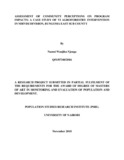Assessment of Community Perceptions on Program Impacts: a Case Study of Vi Agroforestry Intervention in Ndivisi Division, Bungoma East Sub County
Abstract
Programs assess their influence through routine monitoring and evaluation to prove their performance, efficiency, relevance and effectiveness. For a long time, they have employed conventional methods where by the information to be collected are determined by the program team or donors. However, program beneficiaries who are actively involved in the project implementation are left to only give information required. The study therefore sought to involve the beneficiaries in the assessment of the VI Agroforestry’s project. The objectives of the study were to: assess the extent to which the project created change in the lives of beneficiaries; components of livelihood perceived to have changed; changes in food security and credit access. The study was conducted in Ndivisi Division and the target population was individuals who were in active savings groups. The study employed the use of most significant change technique and the influence matrix which belong to tiny tools of program evaluation by the IDEAS to complement each other. The study adopted three steps of the most significant change that is, collection of stories from beneficiaries’, panel analysis of the stories and feedback of the finding. The influence matrix was used during the focus group discussion to identify and rate program activities on the selected domains of change. A total of 43 project beneficiaries who were purposively selected participated in the study they included 19 individuals and 24 participants from two focus group discussions. The results from the stories narrated by the beneficiaries revealed the VI agroforestry had improved the livelihood of the beneficiaries. The key aspects that had changed were food security, credit access, income levels and health as there was increased farm yields. The produce is a source of food and the surplus is sold to generate income, credit was also easily accessible and repayment is on flexible terms. To improve on the program, impact the organization may consider more involvement of the ordinary beneficiaries not the group leaders as this will allow for more buy in and save on time involved in convincing others to participate in the program as well as provide grants on time to allow for enough time for implementation of the program
Publisher
University of Nairobi
Rights
Attribution-NonCommercial-NoDerivs 3.0 United StatesUsage Rights
http://creativecommons.org/licenses/by-nc-nd/3.0/us/Collections
The following license files are associated with this item:


